In order to understand everything about Eastern Lowland gorillas (Gorilla beringei graueri), we need to first discuss the major species and subspecies of gorillas. There are two species of gorillas – The Eastern and Western Gorilla. The Eastern gorilla is divided into two subspecies – Grauer’s Gorilla (Eastern Lowland Gorillas) and Mountain gorillas. Western gorillas are also grouped into two subspecies – The Cross River Gorilla and Western Lowland Gorillas.
Eastern Lowland Gorillas live in tropical rain-forests found in both lowland and mountainous parts of the Eastern Democratic Republic of Congo. The largest groups live in Kahuzi-Biega National Park. 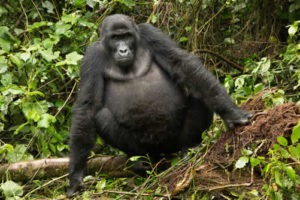 Maiko National Park is also home to large populations of Eastern Lowland gorillas. Smaller adjacent reserves and forests like the Itombwe Massif, Tayna Gorilla reserve and Usala forest also host smaller populations.
Maiko National Park is also home to large populations of Eastern Lowland gorillas. Smaller adjacent reserves and forests like the Itombwe Massif, Tayna Gorilla reserve and Usala forest also host smaller populations.
Eastern Lowland gorillas got that name because scientists thought they only lived in lowland forests. However, it was later found that many families lived in higher altitudes and mountainous areas – Around the same altitude as mountain gorillas. Scientists now refer to them as Grauer’s gorillas because the name Eastern Lowland gorilla is no-longer accurate. The name Eastern Lowland gorilla is still widely used in literature and because of that, we will be using both names interchangeably in the following chapters.
Facts about Eastern Lowland Gorillas
Eastern Lowland gorillas are the largest of the four gorilla sub-species. Yes! Larger than even mountain gorillas. Unfortunately, fewer than 6,000 remain in the wild. An Adult male Grauer’s Gorilla weighs about 250kg. They live in groups consisting of up to 30 individuals led by a dominant silverback. A typical gorilla group consists of females, adolescents, infants and a silverback or two. Eastern 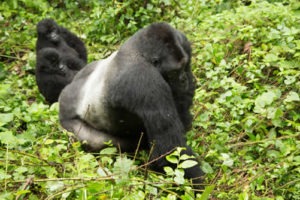 Lowland gorillas feed on leaves, fruits, stems, tree bark, ants or termites. Grauer’s Gorillas are very peaceful and social primates. The dominant silverback protects group members from intruders and attacks. Attacks can be from lone silverbacks planning a takeover or leopards. Female gorillas reach maturity at 8 or 12 years of age. Females initiate the breeding process once they are ready for copulation. Once she conceives, the female will give birth after 9 months. The infant will stay close to the mother and rely on breast milk for three years. What happens to male gorillas in the group? Once a male reaches maturity, it will leave the group to live alone or with other younger males. The young silverback will eventually form its own group by grabbing females from other silverbacks.
Lowland gorillas feed on leaves, fruits, stems, tree bark, ants or termites. Grauer’s Gorillas are very peaceful and social primates. The dominant silverback protects group members from intruders and attacks. Attacks can be from lone silverbacks planning a takeover or leopards. Female gorillas reach maturity at 8 or 12 years of age. Females initiate the breeding process once they are ready for copulation. Once she conceives, the female will give birth after 9 months. The infant will stay close to the mother and rely on breast milk for three years. What happens to male gorillas in the group? Once a male reaches maturity, it will leave the group to live alone or with other younger males. The young silverback will eventually form its own group by grabbing females from other silverbacks.
Difference Between Grauer’s Gorillas and Mountain gorillas
The difference between Eastern Lowland gorillas and Mountain gorillas is interesting given that they look very similar. Remember they are all subspecies of the Eastern gorilla. Whereas Grauer’s Gorilla generally live in lower altitudes, Mountain gorillas live in areas considered to be at higher altitudes. This difference has been questioned by new research findings which show that Mountain gorillas in Bwindi and Virunga National Park live in areas considered of low altitude. It is also important to not that Grauer’s Gorillas have been observed thriving in mountainous and high altitude areas. It is one of the reasons why most scientists no-longer feel comfortable referring to them as Eastern Lowland gorillas.
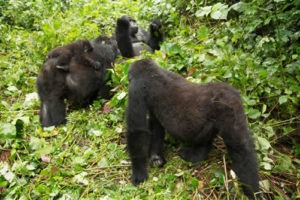 Although fewer in number, mountain gorillas are found in three countries. They can be seen Mgahinga National Park of Uganda, Bwindi National Park of Uganda, Virunga National Park of Congo and the Volcanoes National Park of Rwanda. Eastern Lowland Gorillas are only found in the Democratic Republic of Congo. It is important to point out that Eastern Lowland gorillas are generally large in size compared to mountain gorillas. Mountain gorillas have shorter jaws and arms. That said, Eastern lowland gorillas have shorter teeth and smaller noses compared to Mountain gorillas. Mountain gorillas have longer and thicker coats compared to Eastern Lowland gorillas.
Although fewer in number, mountain gorillas are found in three countries. They can be seen Mgahinga National Park of Uganda, Bwindi National Park of Uganda, Virunga National Park of Congo and the Volcanoes National Park of Rwanda. Eastern Lowland Gorillas are only found in the Democratic Republic of Congo. It is important to point out that Eastern Lowland gorillas are generally large in size compared to mountain gorillas. Mountain gorillas have shorter jaws and arms. That said, Eastern lowland gorillas have shorter teeth and smaller noses compared to Mountain gorillas. Mountain gorillas have longer and thicker coats compared to Eastern Lowland gorillas.
Adult male Eastern Lowland gorillas can reach 210 kilograms while a male mountain gorilla on average reaches 195 kilograms. In both sub-species of gorillas, the group is led by the strongest and most dominant silverback. That said, Grauer’s gorilla groups usually have only one mature silverback in the group. This silverback will drive away all the males as soon as they mature or start to question his authority. Mountain gorilla groups can have more than one mature silverback.
Mountain gorillas have been observed isolating themselves away from their group if isolated or angry. This is particularly so with the dominant silverback. He will emit a strong odor to warn off other members of the group and remain alone for a period of time. This habit of forced isolation when angry has not been observed with Eastern Lowland gorillas.
Protecting Grauer’s gorillas
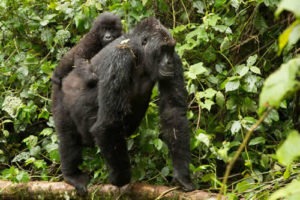 About 4000 Grauer’s Gorillas still roam the wilds of Africa. That is not good news when you consider that there were over 16,000 individuals recorded in the 1990’s. Whereas there are more Eastern lowland gorillas compared to mountain gorillas, their numbers are reducing at a far higher rate. Like all gorilla sub-species, their greatest threat comes from habitat destruction by humans. Humans destroy forests for mining, agriculture or logging purposes. Poaching, civil unrest and inbreeding also account for the rapidly decreasing numbers of Eastern Lowland gorillas.
About 4000 Grauer’s Gorillas still roam the wilds of Africa. That is not good news when you consider that there were over 16,000 individuals recorded in the 1990’s. Whereas there are more Eastern lowland gorillas compared to mountain gorillas, their numbers are reducing at a far higher rate. Like all gorilla sub-species, their greatest threat comes from habitat destruction by humans. Humans destroy forests for mining, agriculture or logging purposes. Poaching, civil unrest and inbreeding also account for the rapidly decreasing numbers of Eastern Lowland gorillas.
The declining numbers of Eastern Lowland Gorillas has led to their inclusion in the list of critically endangered species by the the International Union for Conservation of Nature. The number of mountain gorillas continues to rise every year as a result of greater awareness of their plight and exposure. The same effort, awareness and attention should be given to the Grauer’s Gorilla, the largest ape in the world. There are very few Eastern Lowland gorillas found in captivity and they would be lost forever if they became extinct in the wild. Greater awareness about their plight, involvement of local communities in their protection, promotion of gorilla tourism in Eastern Congo, a return to peace and more interest from the government of Congo will save the Eastern Lowland Gorilla from extinction.
Where to see Eastern Lowland Gorillas
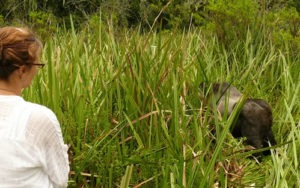 What is the best way to support Grauer’s Gorilla conservation initiatives? Promoting Gorilla Tourism is arguably the best way to support gorilla conservation in Africa. By visiting the gorillas in Africa, you help generate funds required to recruit armed Rangers, build infrastructure and carry out border patrols. Tourism brings jobs to communities living close to the gorillas. They can work as Guides or sell some of their products to Tourists. A community which benefits from tourism will report poachers and ensure that no harm comes to the primates. They will also not destroy forests or gorilla habitats because it would be like destroying their livelihoods. One the main reasons why mountain gorilla conservation has proven to be successful is because tourism is highly promoted and proceeds shared with the local communities. Tourism many is used to build schools, water sources and hospitals.
What is the best way to support Grauer’s Gorilla conservation initiatives? Promoting Gorilla Tourism is arguably the best way to support gorilla conservation in Africa. By visiting the gorillas in Africa, you help generate funds required to recruit armed Rangers, build infrastructure and carry out border patrols. Tourism brings jobs to communities living close to the gorillas. They can work as Guides or sell some of their products to Tourists. A community which benefits from tourism will report poachers and ensure that no harm comes to the primates. They will also not destroy forests or gorilla habitats because it would be like destroying their livelihoods. One the main reasons why mountain gorilla conservation has proven to be successful is because tourism is highly promoted and proceeds shared with the local communities. Tourism many is used to build schools, water sources and hospitals.
Where can you see Eastern Lowland gorillas? Kahuzi-Biega National Park in the Democratic Republic of Congo is arguably the best place to see Eastern Lowland Gorillas. Found in the Eastern part of Congo, Kahuzi-Biega is home to three habituated Grauer’s Gorilla Groups. An Eastern Lowland gorilla permit costs $450. Apart fro the cost of the permit, you have to prepare to pay for meals, ground transportation, accommodation and air-tickets. Mountain gorilla trekking is more popular than Eastern Lowland Gorilla Trekking for several reasons. One reason is that Mountain gorillas have received a lot of publicity since the times of the great Dian Fossey. This great primatologist established base in Rwanda and helped inform the world about mountain gorillas in a way that has not been replicated with Grauer’s gorillas. Eastern Lowland gorillas also happen to live in remote and volatile parts of Congo. Militia and rebel elements are active close to Kahuzi-Biega National Park. Their presence close to the park has kept away many tourists even though strong measures to keep the rebels at bay is in place. It is important to also note that tourism infrastructure like roads and high-end accommodation facilities are not well developed in Congo. The government has also been less aggressive when it comes to promoting what the country has to offer international travelers.


